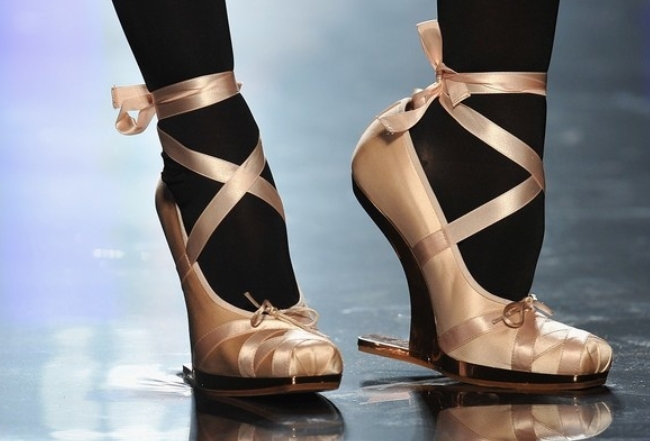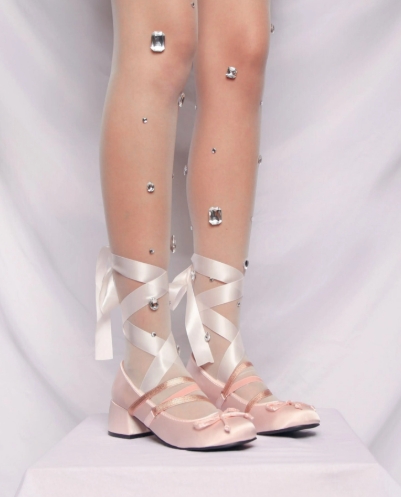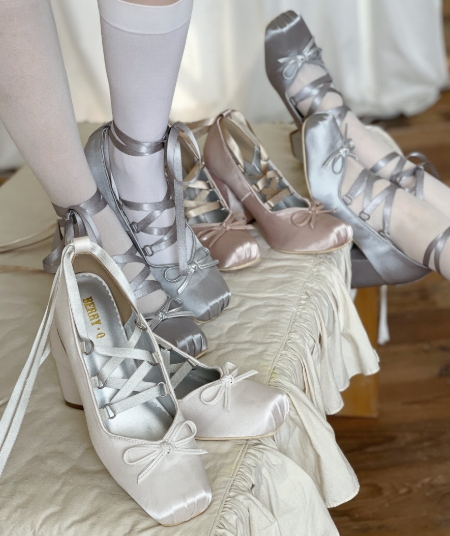Content Menu
● What Are Ballet Heel Shoes?
>> Construction and Design
● The Historical Evolution of Ballet Heels
>> From Heeled Ballet Shoes to Modern Ballet Flats
>> The Rise of Pointe Shoes and Fetish Influence
● Ballet Heel Shoes and Female Dominance
>> Symbolism and Power Dynamics
>> Do Dominant Women Actually Wear Ballet Heels?
● The Experience of Wearing Ballet Heel Shoes
>> Physical Demands
>> Psychological Impact
● Learning to Wear Ballet Heels: Tips and Techniques
>> Choosing the Right Pair
>> Starting Small
>> Mastering Balance
>> Practice Makes Perfect
>> Safety First
● Ballet Heels in Fashion and Pop Culture
>> Fashion Trends
>> Pop Culture and Celebrity Influence
● The Debate: Empowerment or Constraint?
● The Cultural and Psychological Significance of Ballet Heels
>> Ballet Heels as a Symbol of Independence
>> Fetishism, Fashion, and the Allure of the Extreme
● Ballet Heels: Practical Realities and Limitations
>> Not for Everyday Wear
>> Quality and Craftsmanship
● Ballet Heels and the Future of Fashion
● Conclusion
● FAQ: Ballet Heel Shoes and Dominant Women
>> 1. Are ballet heel shoes only worn by dominant women?
>> 2. Are ballet heel shoes safe to wear?
>> 3. Can you walk in ballet heel shoes?
>> 4. Why are ballet heel shoes associated with dominance?
>> 5. Do ballet heel shoes appear in mainstream fashion?
● Citations:
The intersection of fashion, power, and identity is nowhere more visible than in the world of extreme footwear. Among the most striking examples are ballet heel shoes—a provocative blend of ballet pointe aesthetics and the allure of high heels. These shoes, with their impossibly high arches and toe-standing design, have become an iconic symbol within certain fashion and fetish communities. But do dominant women wear ballet heel shoes? What do these shoes represent, and how do they function as signals of dominance, confidence, and style? This comprehensive exploration delves into the history, cultural significance, and practical realities of ballet heel shoes, with a special focus on their association with dominant women.

What Are Ballet Heel Shoes?
Ballet heel shoes, also known as ballet boots or ballet heels, are a unique type of footwear that merges the aesthetics of the classical ballet pointe shoe with the dramatic elevation of high heels. The defining feature is their extreme heel height—usually seven inches (18 cm) or more—which forces the wearer's foot into a near-vertical, fully extended position, similar to a dancer en pointe. The result is a shoe that is both visually arresting and physically challenging.
Construction and Design
- Heel Height: Typically 7 inches or higher, designed to mimic the pointed foot of a ballerina.
- Structure: Many styles feature a reinforced toe box and shank, similar to pointe shoes, but with the addition of a high heel for support.
- Styles: Available as boots (ankle, knee-high, thigh-high), sandals, mules, and Mary Janes. Some have zippers, laces, or buckles for added support and aesthetics.
- Materials: Leather, patent leather, suede, and occasionally latex or PVC for a fetish-inspired look.
The Historical Evolution of Ballet Heels
From Heeled Ballet Shoes to Modern Ballet Flats
The story of ballet footwear is one of constant evolution, reflecting shifts in both fashion and function. The original ballet shoe, interestingly, was a high-heeled version that made its first appearance in 1680s France at the Royal Academy of Dance[1][5][6]. These shoes, ornate and impractical, were designed more for aesthetics than movement, echoing the fashion priorities of the era. However, the discomfort and impracticality of these early heeled shoes led to a gradual shift toward flat, flexible slippers that allowed dancers to showcase their technique and artistry[1][5][6].
A pivotal moment came in the 1730s when Paris Opera Ballet dancer Marie Camargo removed the heel from her shoes, creating the first ballet slipper and revolutionizing dance by allowing for greater freedom of movement[6]. This innovation paved the way for the development of the pointe shoe, which would later become a symbol of both technical prowess and ethereal beauty in ballet[4][6].
The Rise of Pointe Shoes and Fetish Influence
The pointe shoe, introduced in the 19th century and popularized by ballerinas like Marie Taglioni, enabled dancers to rise onto the tips of their toes, creating the illusion of weightlessness and supernatural grace[4][6]. Yet, as ballet shoes became more functional and supportive, a parallel trend emerged in the world of fetish fashion.
Around the turn of the 20th century, Viennese fetish boots appeared, featuring dramatic 11-inch heels that were longer than the shoe sole, making standing or walking impossible[2]. These boots, designed more for visual impact and erotic appeal than practicality, are direct ancestors of today's ballet heel shoes[2]. By the 1980s, ballet boots and shoes had gained popularity in fetish and alternative fashion circles, becoming more widely available and diverse in design[2].
Ballet Heel Shoes and Female Dominance
Symbolism and Power Dynamics
High heels have long been associated with femininity, sexuality, and power. Ballet heels, by exaggerating these elements, take on an even more potent symbolism. In the context of dominance, they serve several functions:
- Visual Command: The extreme posture and striking silhouette command attention, projecting confidence and authority.
- Physical Challenge: Mastery of such difficult footwear signals control, discipline, and strength—traits often associated with dominance.
- Fetish and BDSM: Ballet boots are popular in BDSM and fetish communities, where they can symbolize both dominance (the wearer) and submission (the discomfort or restriction imposed)[2][3].
Do Dominant Women Actually Wear Ballet Heels?
Yes, many dominant women—particularly those in the BDSM, fetish, and alternative fashion scenes—choose ballet heel shoes as part of their wardrobe. The shoes serve as a powerful visual signal of authority and sexual confidence, often paired with other elements of dominant attire such as corsets, latex, or leather.
- Fashion Shoots: Ballet heels are frequently featured in fashion photography, often styled on models in commanding, dominant poses.
- BDSM Play: In kink contexts, dominant women may wear ballet boots as a form of erotic power display, sometimes incorporating them into roleplay or scenes focused on control and restraint[2][3].
- Pop Culture: Celebrities like Beyoncé and Christina Aguilera have worn ballet boots in music videos and performances, reinforcing their association with bold, dominant femininity[2].
The Experience of Wearing Ballet Heel Shoes
Physical Demands
Wearing ballet heels is not for the faint of heart. The shoes force the foot into an unnatural position, requiring significant strength, flexibility, and practice to wear—even for short periods.
- Pain and Discomfort: Beginners often find standing or walking in ballet heels extremely difficult and painful. Calf cramps, toe pressure, and balance issues are common[2][3].
- Training: Some enthusiasts use arch-training devices or gradually increase heel height to build the necessary strength and flexibility[2][3].
- Safety: Prolonged use can cause injury if not approached carefully. Many wearers use padding, tape, or custom-fitted shoes to reduce risk[3].
Psychological Impact
Despite (or because of) the challenge, many wearers report feelings of empowerment, confidence, and heightened sexuality when donning ballet heels. The shoes force a proud, upright posture and draw attention, which can be both exhilarating and intimidating.
Learning to Wear Ballet Heels: Tips and Techniques
Choosing the Right Pair
- Quality Matters: Look for sturdy construction and quality materials to ensure the shoes can support your weight and provide stability[3].
- Fit: The fit should be snug but not tight, with enough room for your toes to move comfortably[3].
Starting Small
- Gradual Progression: If you're new to ballet heels, start with a lower heel and work your way up. Practice walking in regular high heels and gradually increase the height as you become more comfortable[3].
- Strength Building: Focus on building up strength in your feet, ankles, and core before attempting to walk in ballet heels[3].
Mastering Balance
- Posture: Walking in ballet heels requires a different technique than regular heels. Keep your legs straight and your body upright, engaging your core muscles for stability[3].
- Small Steps: Take small, deliberate steps, relying on your thighs for movement rather than your calves, which can quickly become overworked[3].
Practice Makes Perfect
- Safe Surfaces: Start practicing on a soft surface like carpet, which provides more traction and cushioning than hard floors[3].
- Mirror Work: Stand in front of a mirror to observe your posture and correct any imbalances[3].
- Incremental Progress: Practice shifting your weight and taking a few steps before moving to harder surfaces or longer wear times[3].
Safety First
- Listen to Your Body: Never ignore pain or discomfort. Ballet heels are not designed for long periods of standing or walking, and overuse can lead to injury[3].
- Use for Special Occasions: Consider wearing ballet heels for photoshoots, performances, or specific scenes rather than as everyday footwear[3].

Ballet Heels in Fashion and Pop Culture
Fashion Trends
While ballet flats and pumps have become mainstream fashion staples, ballet heels remain a niche but influential trend. They appear periodically on runways, in editorial shoots, and in the wardrobes of avant-garde fashion icons[2].
- Balletcore: The recent resurgence of ballet-inspired fashion—balletcore—has brought renewed interest to all things ballet, from soft slippers to dramatic heels. Ballet heels, with their theatrical flair, are sometimes featured in high-fashion collections as statement pieces[6].
- Editorial Shoots: Fashion magazines and photographers often use ballet heels to create visually arresting images that play with themes of power, restriction, and sensuality.
Pop Culture and Celebrity Influence
- Music Videos: Ballet boots have appeared in music videos, worn by pop stars to convey strength, confidence, and sexual empowerment[2].
- Social Media: Platforms like Instagram and TikTok feature influencers and models showcasing ballet heels in both fashion and fetish contexts, further blurring the lines between mainstream and alternative style.
The Debate: Empowerment or Constraint?
Ballet heel shoes occupy a complex space in the discourse around female empowerment and bodily autonomy.
- Empowerment: For some, mastering ballet heels is an act of self-expression and control, a way to reclaim and exaggerate traditional symbols of femininity and sexuality.
- Constraint: Others argue that the discomfort and restriction imposed by such shoes reflect societal pressures on women to endure pain for beauty or sexual appeal.
Ultimately, the meaning of ballet heels depends on context, intention, and the wearer's relationship to their own body and identity.
The Cultural and Psychological Significance of Ballet Heels
Ballet Heels as a Symbol of Independence
Ballet shoes, in general, have long been a representation of femininity, elegance, and timelessness. Their evolution from uncomfortable, high-heeled court shoes to practical, flexible flats mirrored a broader shift toward independence and self-expression for women[5]. Ballet heels, by contrast, take the aesthetics of pointe work to an extreme, challenging conventional ideas about comfort and beauty.
For dominant women, ballet heels can be a tool for asserting independence and control—both over their own bodies and within social or sexual dynamics. The ability to master such challenging footwear becomes a metaphor for overcoming obstacles and embracing one's power.
Fetishism, Fashion, and the Allure of the Extreme
The allure of ballet heels is not limited to their visual impact. The shoes also tap into deeper psychological themes:
- Taboo and Transgression: Ballet heels, by their very design, transgress the boundaries of what is considered practical or normal in footwear. This sense of taboo adds to their erotic and psychological appeal.
- Bondage and Restriction: In fetish contexts, the physical restriction imposed by ballet heels can serve as a form of bondage, heightening sensations of vulnerability or control[2].
- Performance and Spectacle: Whether worn on stage, in photoshoots, or in private, ballet heels transform the act of walking or standing into a performance—one that demands attention and admiration.
Ballet Heels: Practical Realities and Limitations
Not for Everyday Wear
Despite their dramatic appeal, ballet heels are not practical for everyday use. Most wearers use them for specific occasions—photoshoots, performances, or private play—rather than as daily footwear[2][3]. The risk of injury, combined with the physical demands of wearing the shoes, limits their use to those who are willing to invest time and effort into training and preparation.
Quality and Craftsmanship
The quality of ballet heels varies widely. High-quality pairs, designed for actual walking or standing, feature reinforced construction and careful attention to fit and support. Low-quality versions, often intended purely as fetish objects, may be unsuitable for any weight-bearing activity and can be dangerous to wear[2][3].
Ballet Heels and the Future of Fashion
As fashion continues to evolve, the boundaries between mainstream and alternative styles are becoming increasingly blurred. Ballet heels, once confined to the world of fetish and avant-garde fashion, are now finding their way into broader cultural conversations about gender, power, and self-expression.
- Inclusivity: The growing visibility of ballet heels in pop culture and social media is helping to challenge stereotypes about who can wear extreme footwear and why.
- Innovation: Designers continue to experiment with new materials, constructions, and styles, pushing the limits of what ballet heels can be.
- Empowerment: For many, the act of wearing ballet heels—whether as a dominant woman, a performer, or simply a fashion enthusiast—remains a powerful statement of individuality and confidence.
Conclusion
Ballet heel shoes are more than just extreme footwear—they are potent symbols at the intersection of fashion, sexuality, and power. For many dominant women, especially within the BDSM and fetish communities, ballet heels serve as both a visual and psychological tool of authority, confidence, and self-expression. While not practical for everyday wear, they command attention, challenge the wearer, and blur the boundaries between fashion and fetish, dominance and submission.
Whether seen as an act of empowerment, a statement of style, or a tool of erotic play, ballet heel shoes remain a fascinating and provocative element of modern culture. Their history, from the courts of 17th-century France to the runways and fetish clubs of today, reflects broader shifts in attitudes toward gender, power, and self-presentation. As fashion continues to evolve, ballet heels will likely remain a symbol of both the allure and the challenge of extreme femininity.

FAQ: Ballet Heel Shoes and Dominant Women
1. Are ballet heel shoes only worn by dominant women?
No, ballet heel shoes are worn by a variety of people, including submissive individuals in BDSM contexts, fashion enthusiasts, and performers. However, they are commonly associated with dominant women due to their commanding appearance and challenging nature.
2. Are ballet heel shoes safe to wear?
Ballet heel shoes can be dangerous if not worn properly. They require significant strength, balance, and practice. Beginners should use caution, limit wear time, and consider custom-fitted shoes and protective padding.
3. Can you walk in ballet heel shoes?
With training and the right shoe construction, some people can walk short distances in ballet heels. However, many styles are intended primarily for posing, photography, or fetish play rather than practical movement.
4. Why are ballet heel shoes associated with dominance?
The extreme posture and difficulty of ballet heels project confidence, control, and authority—traits often linked to dominance. In fetish contexts, they also symbolize power dynamics between wearer and observer or submissive partner.
5. Do ballet heel shoes appear in mainstream fashion?
While ballet flats and pumps are mainstream, ballet heels remain niche. However, they occasionally appear in high-fashion editorials, runway shows, and pop culture, often as statements of avant-garde style or empowered femininity.
Citations:
[1] https://startupfashion.com/fashion-archives-history-ballet-flat/
[2] https://en.wikipedia.org/wiki/Ballet_boot
[3] https://www.bananashoes.com/blogs/the-blog/fetish-ballet-heels
[4] https://pointemagazine.com/history-of-pointe-shoes/
[5] https://www.minodance.com.au/blogs/dance-uniforms-2/ballet-shoes-the-historical-and-cultural-significance-of-ballet-flats
[6] https://australianballet.com.au/blog/history-en-pointe
[7] https://www.satra.com/bulletin/article.php?id=3250
[8] https://www.charleskeith.com/hk-en/guides/ballet-flats.html
[9] https://www.harpersbazaar.com/uk/fashion/shows-trends/a36109411/ballet-pumps/
[10] https://historyatnorthampton.com/2022/03/03/ballet-and-the-history-of-shoes/
[11] https://frankie4.com/blogs/news/btd-ballet-flats
[12] https://www.deviantart.com/herpinktevasandals/art/Fetish-Ballet-Flats-1056680855
[13] https://dancemagazine.com/dancers-and-their-shoes/
[14] https://www.pinterest.com/pin/lat--550635491957654410/
[15] https://en.wikipedia.org/wiki/Ballet_shoe
[16] https://theconversation.com/ballet-flats-are-back-heres-what-the-research-says-about-how-they-affect-your-feet-207806
[17] https://www.reddit.com/r/poledancing/comments/1deduwo/ballet_heel_boots_for_pole_dance/
[18] https://www.aerosoles.com/blogs/news/history-of-the-ballet-flat
[19] https://www.whowhatwear.com/fashion/shoes/best-ballet-pumps
[20] https://www.kennedy-center.org/education/resources-for-educators/classroom-resources/media-and-interactives/media/dance/pointe-shoes/

















